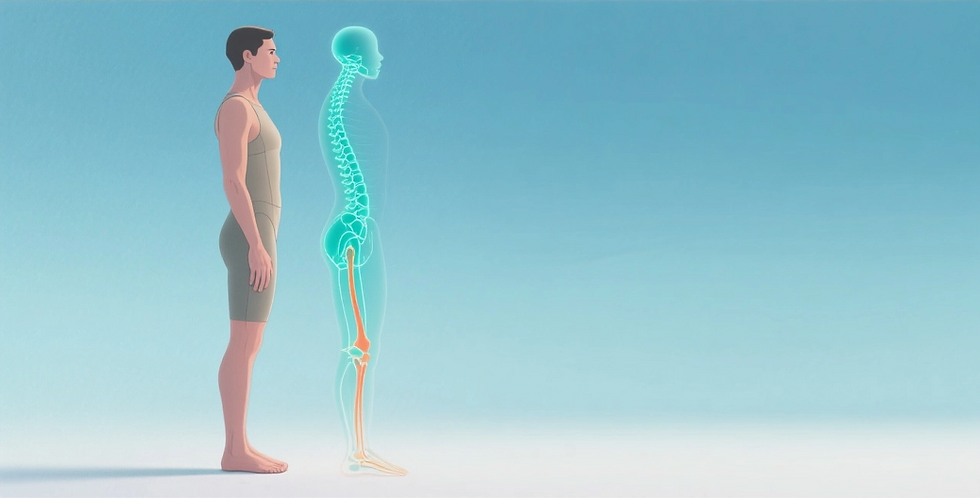The Connection Between Modern Shoes and Tight Hamstrings: How Your Footwear Choices Could be Impacting Your Flexibility
- Luc

- Jan 7
- 4 min read
Updated: Mar 9

Elevated Heels and Altered Posture:
Many modern shoes, even athletic ones, have a raised heel (heel-to-toe drop). This design shifts the body’s center of gravity forward, forcing compensatory adjustments throughout the kinetic chain.
To maintain balance, the pelvis may tilt posteriorly, and the hamstrings can become chronically shortened or overactive to stabilize the pelvis and counteract the forward shift.
Reduced Ankle Mobility:
Elevated heels and stiff soles limit the natural range of motion in the ankle joint, particularly dorsiflexion (the ability to bring the toes toward the shin).
When ankle mobility is restricted, the body compensates by recruiting other muscles, such as the hamstrings, to assist in movements like walking, running, or squatting. Over time, this can lead to tightness and overuse of the hamstrings.
Weakening of the Foot Muscles:
Cushioned and supportive shoes reduce the need for the intrinsic muscles of the feet to engage and stabilize. This can lead to weak foot muscles and collapsed arches, which in turn affect the alignment of the entire lower body.
Poor foot alignment (e.g., overpronation or flat feet) can cause the hamstrings to work harder to stabilize the legs and pelvis, contributing to tightness.
Restricted Toe Splay and Natural Movement:
Narrow toe boxes in modern shoes prevent the toes from spreading naturally, which is essential for proper weight distribution and balance.
This restriction can lead to compensatory patterns in the legs and hips, placing additional strain on the hamstrings.
The Chain Reaction: From Feet to Hamstrings to Neck
The body is an interconnected system, and dysfunction in one area can have cascading effects throughout the kinetic chain. Here’s how modern shoes might indirectly contribute to neck pain via tight hamstrings:
Foot Dysfunction:
Modern shoes alter the natural biomechanics of the feet, leading to poor alignment and reduced mobility.
This dysfunction travels up the chain, affecting the knees, hips, and pelvis.
Tight Hamstrings:
As the pelvis tilts posteriorly or compensates for poor foot mechanics, the hamstrings become tight and overactive.
This tightness disrupts the alignment of the pelvis and spine.
Spinal Misalignment:
A misaligned pelvis affects the curvature of the spine, particularly the lumbar and thoracic regions.
To compensate, the neck extensors become overactive, leading to tightness and pain in the neck.
Supporting Evidence
Barefoot and Minimalist Footwear Studies:
Research on barefoot or minimalist footwear suggests that allowing the feet to move naturally can improve posture, strengthen foot muscles, and reduce compensatory patterns in the legs and pelvis.
Individuals who transition to barefoot or minimalist shoes often report improvements in hamstring flexibility and reduced tension in the posterior chain.
Ancestral Movement Patterns:
Humans evolved to walk and run barefoot or in minimal footwear, which promotes natural alignment and muscle engagement. Modern shoes disrupt these natural patterns, leading to imbalances like tight hamstrings.
Addressing the Root Cause
If modern shoes are contributing to tight hamstrings, here are some steps to address the issue:
Transition to Minimalist Footwear:
Gradually switch to shoes with a lower heel-to-toe drop, wider toe box, and minimal cushioning to allow for natural foot movement.
Be cautious and transition slowly to avoid injury, as your feet and legs will need time to adapt.
Strengthen the Feet and Ankles:
Perform exercises like toe spreads, calf raises, and barefoot walking to strengthen the intrinsic muscles of the feet and improve ankle mobility.
Stretch and Mobilize the Hamstrings:
Incorporate dynamic stretches and mobility exercises for the hamstrings, such as leg swings and active forward folds, to release tension.
Address Postural Alignment:
Work on improving overall posture through core strengthening, hip mobility exercises, and awareness of pelvic alignment.
Go Barefoot When Possible:
Spend time barefoot or in socks at home to allow your feet to move naturally and strengthen over time.
Conclusion:
In my opinion, modern shoes may be a root cause of tight hamstrings because, while they are not functional, they create disturbances in the walking gait. Their design and primary purpose are often focused on aesthetics rather than supporting natural movement. Most modern footwear disrupts natural biomechanics, leading to compensatory patterns that can tighten the hamstrings and affect the entire posterior chain. By addressing footwear choices and focusing on restoring natural movement patterns, it’s possible to alleviate tight hamstrings and prevent downstream effects, including neck pain.
This is not medical advice but rather my perspective, based on my own past experiences and observations of how people struggle with overall pain and injuries.
If the text above resonates with you, feel free to contact me or schedule an appointment.
The following scientific study proves this:
The study titled "Postural alignment in barefoot and high-heeled stance" (PMID: 3187700) examines the effects of footwear on posture. It highlights how high-heeled shoes alter the body's natural alignment compared to being barefoot. Key findings include:
Lumbar Flattening and Pelvic Tilt: High heels cause a flattening of the lumbar spine and a backward tilt of the pelvis.
Shift in Gravity: Wearing high heels reduces the distance of the knees and ankles from the body's line of gravity, leading to compensatory postural changes.
Spinal and Head Displacement: The thoracic spine and head shift posteriorly in response to the altered alignment.
Long-term Effects: While immediate changes include lumbar flattening, habitual high-heel wearers may develop hyperlordosis (excessive inward curvature of the spine) over time due to changes in postural muscle tone.
This research supports the idea that footwear significantly impacts posture and biomechanics, with high heels causing compensatory adjustments that may lead to long-term musculoskeletal issues.
Study link; https://pubmed.ncbi.nlm.nih.gov/3187700/





Comments